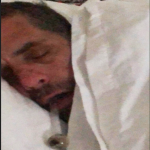vpaps vs. bipaps
- DreamStalker
- Posts: 7509
- Joined: Mon Aug 07, 2006 9:58 am
- Location: Nowhere & Everywhere At Once
vpaps vs. bipaps
Anyone able to explain differences if there are any?
Thanks
Thanks
President-pretender, J. Biden, said "the DNC has built the largest voter fraud organization in US history". Too bad they didn’t build the smartest voter fraud organization and got caught.
-
brackstone
- Posts: 168
- Joined: Sun Jul 16, 2006 5:42 pm
Hi Dream Stalker!
I was just at my doctors office obtaining a script for my Bi-Pap so I actually had this discussion with the tech. My script called for a VPAP which is how I ended up with my Auto Bi-Pap.
If our theory was correct the VPAP is just another way to say APAP so it will auto titrate itself while you sleep. Where as the Bi-Pap if it's set to 5/10 will just change between those two pressures only.
I remember this because I was telling him I wanted to buy the Auto Bi-Pap but he told me I didn't need it since I was just using the Bi-Pap since I was only using 5/10 but I told him I wanted the Auto in case in the future I wanted the variable pressure.
I was just at my doctors office obtaining a script for my Bi-Pap so I actually had this discussion with the tech. My script called for a VPAP which is how I ended up with my Auto Bi-Pap.
If our theory was correct the VPAP is just another way to say APAP so it will auto titrate itself while you sleep. Where as the Bi-Pap if it's set to 5/10 will just change between those two pressures only.
I remember this because I was telling him I wanted to buy the Auto Bi-Pap but he told me I didn't need it since I was just using the Bi-Pap since I was only using 5/10 but I told him I wanted the Auto in case in the future I wanted the variable pressure.
-
Snoozeomatic
- Posts: 17
- Joined: Thu Dec 28, 2006 8:44 pm
- Location: Indiana
Hi Dreamstalker
I can't say how the bipap works since I use a vpap, but I can tell you
how the vpap works. My inhale pressure is 18 & exhale at 14. It self adjust
to my breathing patterns & if they change so does it, but not with more pressure but when to start the next breath based on the last few I have
taken. (Not very good at explaining this) but maybe it will help some.
Is this how a bipap works??
Ron
I can't say how the bipap works since I use a vpap, but I can tell you
how the vpap works. My inhale pressure is 18 & exhale at 14. It self adjust
to my breathing patterns & if they change so does it, but not with more pressure but when to start the next breath based on the last few I have
taken. (Not very good at explaining this) but maybe it will help some.
Is this how a bipap works??
Ron
Brackstone,
I think a Vpap is just a straight bi-level, if what you have (or are getting) auto titrates, then you have a Vpap auto.
Vpap does not automatically equal apap, unless it is an auto, in which case it is an auto-vpap. If bpap equals apap, then reverse logic would tell us that apap equals bpap, which it does not.
We can shuffle the alphabet around all day long, it still ends up that you'll go to bed with unnatural appendages and a whirly current blowing up your nose.
I think a Vpap is just a straight bi-level, if what you have (or are getting) auto titrates, then you have a Vpap auto.
Vpap does not automatically equal apap, unless it is an auto, in which case it is an auto-vpap. If bpap equals apap, then reverse logic would tell us that apap equals bpap, which it does not.
We can shuffle the alphabet around all day long, it still ends up that you'll go to bed with unnatural appendages and a whirly current blowing up your nose.
-
Snoozeomatic
- Posts: 17
- Joined: Thu Dec 28, 2006 8:44 pm
- Location: Indiana
- rested gal
- Posts: 12881
- Joined: Thu Sep 09, 2004 10:14 pm
- Location: Tennessee
We often refer to any lip balm in a tube as "chapstick", and any facial tissues in a box as "kleenex." Same with "bipap"...we often call any brand of bi-level machine in which EPAP and IPAP pressures are set separately "a bipap machine."
As stages3n4 said, bipap and vpap are both bi-level machines. Not autopaps, and not straight cpap machines, although a bi-level machine can be set to work like a straight CPAP machine just by setting the EPAP and IPAP pressures to the same number.
BiPAP = Respironics's trademark name for its bi-level machine. EPAP pressure is set for exhaling and an IPAP pressure is set higher for inhaling.
Also has a feature called "Bi-Flex" that can be turned on or off. Bi-Flex is similar to C-flex in that bi-flex drops the BEGINNING of the already lower EPAP exhalation pressure a tad lower, and softens the transition in the beginning and end of the IPAP inhalation pressure.
Also has another "comfort" feature that allows setting of the "rise time"...the amount of time in milleseconds that is used for getting up to full inhale pressure when you start to inhale.
You can set one or the other -- bi-flex or rise time, but can't use both in the same operating mode. Personally, I find using bi-flex much more comfortable than setting a rise time. When I did try various rise times, the longest time setting felt best to me, but none felt as much like natural breathing as using bi-flex.
VPAP = resmed's name for its bi-level machine. Rise time can be set, but there's no feature available similiar to bi-flex.
BiPAP Auto = Respironics's name for its bi-level machine with auto-titrating capability. This is not an "autopap" -- it is first and foremost a bi-level machine. It is set with an EPAP pressure for exhaling and higher pressure (IPAP) for inhaling. Auto-titrating is a feature that can be turned on or off when setting the mode for using the BiPAP Auto.
It can be used just as a bi-level (BiPAP) or as an auto-titrating bi-level -- both at same time. It can be used as just a CPAP by setting EPAP and IPAP at the same number. It cannot be used just as an autopap. Bi-Flex can be used, or not, in both its bi-level and auto-titrating bi-level modes.
resmed recently has come out with its version of an auto-titrating bi-level machine called "malibu" in the U.S.
Types of machines:
viewtopic.php?p=56836
"Whats the differences in BIPAP, XPAP, APAP, CFLEX"
As stages3n4 said, bipap and vpap are both bi-level machines. Not autopaps, and not straight cpap machines, although a bi-level machine can be set to work like a straight CPAP machine just by setting the EPAP and IPAP pressures to the same number.
BiPAP = Respironics's trademark name for its bi-level machine. EPAP pressure is set for exhaling and an IPAP pressure is set higher for inhaling.
Also has a feature called "Bi-Flex" that can be turned on or off. Bi-Flex is similar to C-flex in that bi-flex drops the BEGINNING of the already lower EPAP exhalation pressure a tad lower, and softens the transition in the beginning and end of the IPAP inhalation pressure.
Also has another "comfort" feature that allows setting of the "rise time"...the amount of time in milleseconds that is used for getting up to full inhale pressure when you start to inhale.
You can set one or the other -- bi-flex or rise time, but can't use both in the same operating mode. Personally, I find using bi-flex much more comfortable than setting a rise time. When I did try various rise times, the longest time setting felt best to me, but none felt as much like natural breathing as using bi-flex.
VPAP = resmed's name for its bi-level machine. Rise time can be set, but there's no feature available similiar to bi-flex.
BiPAP Auto = Respironics's name for its bi-level machine with auto-titrating capability. This is not an "autopap" -- it is first and foremost a bi-level machine. It is set with an EPAP pressure for exhaling and higher pressure (IPAP) for inhaling. Auto-titrating is a feature that can be turned on or off when setting the mode for using the BiPAP Auto.
It can be used just as a bi-level (BiPAP) or as an auto-titrating bi-level -- both at same time. It can be used as just a CPAP by setting EPAP and IPAP at the same number. It cannot be used just as an autopap. Bi-Flex can be used, or not, in both its bi-level and auto-titrating bi-level modes.
resmed recently has come out with its version of an auto-titrating bi-level machine called "malibu" in the U.S.
Types of machines:
viewtopic.php?p=56836
"Whats the differences in BIPAP, XPAP, APAP, CFLEX"
ResMed S9 VPAP Auto (ASV)
Humidifier: Integrated + Climate Control hose
Mask: Aeiomed Headrest (deconstructed, with homemade straps
3M painters tape over mouth
ALL LINKS by rested gal:
viewtopic.php?t=17435
Humidifier: Integrated + Climate Control hose
Mask: Aeiomed Headrest (deconstructed, with homemade straps
3M painters tape over mouth
ALL LINKS by rested gal:
viewtopic.php?t=17435
Just to add a further 0.2 c worth.
Bilevel is a method of providing pressure relief. It was 1st devised as much as anything, for patients with COPD & other lung complications. It made cpap much easier for such patients to tolerate.
So these machines have special algorithms for sensing when a person has ceased breathing in and breathing out & uses that signal to change from its breath-in (ipap) pressure to its breathe-out (epap) pressure.
Modern Bipaps have a 2nd pressure relief facility in the BiFlex feature - this is n effect relief on the relief. Where it has real value is for those folk who are on a BiLevel at higher pressures (such as ipap > 15 or so).
The gap between ipap & epap can cause problems for some people if it is spread too far apart (say greater than 4 cms). But on some patients who need assisted breathing (where there BiLevel is used as a ventilator) a gap as high as 8 may be used. Again BiFlex helps there. Only BiLevels with 'Timed mode' can be used as ventilators.
The new Sv models from Resmed & Respironics, go about their therapy in yet a different way (Servo Ventilation).
DSM
Bilevel is a method of providing pressure relief. It was 1st devised as much as anything, for patients with COPD & other lung complications. It made cpap much easier for such patients to tolerate.
So these machines have special algorithms for sensing when a person has ceased breathing in and breathing out & uses that signal to change from its breath-in (ipap) pressure to its breathe-out (epap) pressure.
Modern Bipaps have a 2nd pressure relief facility in the BiFlex feature - this is n effect relief on the relief. Where it has real value is for those folk who are on a BiLevel at higher pressures (such as ipap > 15 or so).
The gap between ipap & epap can cause problems for some people if it is spread too far apart (say greater than 4 cms). But on some patients who need assisted breathing (where there BiLevel is used as a ventilator) a gap as high as 8 may be used. Again BiFlex helps there. Only BiLevels with 'Timed mode' can be used as ventilators.
The new Sv models from Resmed & Respironics, go about their therapy in yet a different way (Servo Ventilation).
DSM
xPAP and Quattro std mask (plus a pad-a-cheek anti-leak strap)
- DreamStalker
- Posts: 7509
- Joined: Mon Aug 07, 2006 9:58 am
- Location: Nowhere & Everywhere At Once










